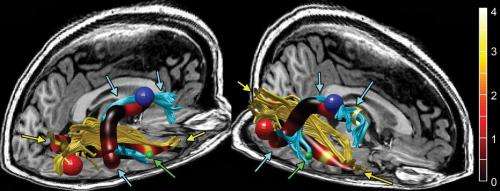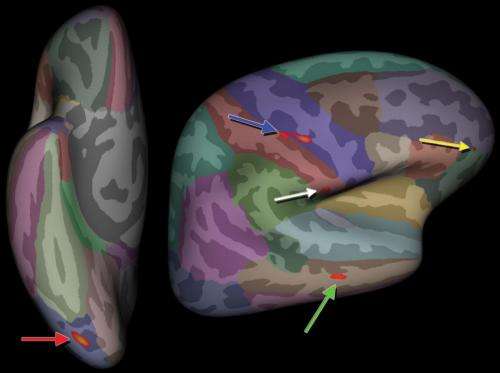Study finds brain abnormalities in chronic fatigue patients

An imaging study by Stanford University School of Medicine investigators has found distinct differences between the brains of patients with chronic fatigue syndrome and those of healthy people.
The findings could lead to more definitive diagnoses of the syndrome and may also point to an underlying mechanism in the disease process.
It's not uncommon for CFS patients to face several mischaracterizations of their condition, or even suspicions of hypochondria, before receiving a diagnosis of CFS. The abnormalities identified in the study, to be published Oct. 29 in Radiology, may help to resolve those ambiguities, said lead author Michael Zeineh, MD, PhD, assistant professor of radiology.
"Using a trio of sophisticated imaging methodologies, we found that CFS patients' brains diverge from those of healthy subjects in at least three distinct ways," Zeineh said.
CFS affects between 1 million and 4 million individuals in the United States and millions more worldwide. Coming up with a more precise number of cases is tough because it's difficult to actually diagnose the disease. While all CFS patients share a common symptom—crushing, unremitting fatigue that persists for six months or longer—the additional symptoms can vary from one patient to the next, and they often overlap with those of other conditions.
Scientific Challenge
"CFS is one of the greatest scientific and medical challenges of our time," said the study's senior author, Jose Montoya, MD, professor of infectious diseases and geographic medicine. "Its symptoms often include not only overwhelming fatigue but also joint and muscle pain, incapacitating headaches, food intolerance, sore throat, enlargement of the lymph nodes, gastrointestinal problems, abnormal blood-pressure and heart-rate events, and hypersensitivity to light, noise or other sensations."
The combination of symptoms can devastate a patient's life for 10, 20 or even 30 years, said Montoya, who has been following 200 CFS patients for several years in an effort to identify the syndrome's underlying mechanisms. He hopes to accelerate the development of more-effective treatments than now exist. (A new Stanford Medicine magazine story describes the study in more detail.)

"In addition to potentially providing the CFS-specific diagnostic biomarker we've been desperately seeking for decades, these findings hold the promise of identifying the area or areas of the brain where the disease has hijacked the central nervous system," Montoya said.
"If you don't understand the disease, you're throwing darts blindfolded," said Zeineh. "We asked ourselves whether brain imaging could turn up something concrete that differs between CFS patients' and healthy people's brains. And, interestingly, it did."
The Stanford investigators compared brain images of 15 CFS patients chosen from the group Montoya has been following to those of 14 age- and sex-matched healthy volunteers with no history of fatigue or other conditions causing symptoms similar to those of CFS.
Three Key Findings
The analysis yielded three noteworthy results, the researchers said. First, an MRI showed that overall white-matter content of CFS patients' brains, compared with that of healthy subjects' brains, was reduced. The term "white matter" largely denotes the long, cablelike nerve tracts carrying signals among broadly dispersed concentrations of "gray matter." The latter areas specialize in processing information, and the former in conveying the information from one part of the brain to another.
That finding wasn't entirely unexpected, Zeineh said. CFS is thought to involve chronic inflammation, quite possibly as a protracted immunological response to an as-yet unspecified viral infection. Inflammation, meanwhile, is known to take a particular toll on white matter.
But a second finding was entirely unexpected. Using an advanced imaging technique—diffusion-tensor imaging, which is especially suited to assessing the integrity of white matter—Zeineh and his colleagues identified a consistent abnormality in a particular part of a nerve tract in the right hemisphere of CFS patients' brains. This tract, which connects two parts of the brain called the frontal lobe and temporal lobe, is called the right arcuate fasciculus, and in CFS patients it assumed an abnormal appearance.
Furthermore, there was a fairly strong correlation between the degree of abnormality in a CFS patient's right arcuate fasciculus and the severity of the patient's condition, as assessed by performance on a standard psychometric test used to evaluate fatigue.
Right vs. Left
Although the right arcuate fasciculus's function is still somewhat mysterious, its counterpart in the brain's left hemisphere has been extensively explored. The left arcuate fasciculus connects two critical language areas of the left side of the brain termed Wernicke's and Broca's areas, which are gray-matter structures several centimeters apart. These two structures are important to understanding and generating speech, respectively. Right-handed people almost always have language organized in this fashion exclusively in the left side of the brain, but the precise side (left or right) and location of speech production and comprehension are not so clear-cut in left-handed people. (It's sometimes said that every left-hander's brain is a natural experiment.) So, pooling left- and right-handed people's brain images can be misleading. And, sure enough, the finding of an abnormality in the right arcuate fasciculus, pronounced among right-handers, was murky until the two left-handed patients and four left-handed control subjects' images were exempted from the analysis.
Bolstering these observations was the third finding: a thickening of the gray matter at the two areas of the brain connected by the right arcuate fasciculus in CFS patients, compared with controls. Its correspondence with the observed abnormality in the white matter joining them makes it unlikely that the two were chance findings, Zeineh said.
Although these results were quite robust, he said, they will need to be confirmed. "This study was a start," he said. "It shows us where to look." The Stanford scientists are in the planning stages of a substantially larger study.
More information: "Right Arcuate Fasciculus Abnormality in Chronic Fatigue Syndrome" Radiology, 2014.













